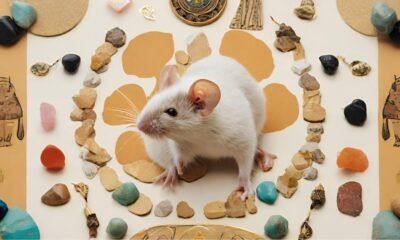Symbolism
– Which animals symbolize resilience and why?

[ad_1]
In this article, we will explore the animals that symbolize resilience and why they are seen in such a way. Animals have long been used as symbols in various cultures and belief systems, representing different qualities and characteristics. Resilience is a trait that is admired and valued in many societies, and certain animals are associated with this attribute due to their ability to overcome challenges and adapt to difficult circumstances.
1. What animals are known for their resilience?
One animal that is often seen as a symbol of resilience is the **phoenix**. In mythology, the phoenix is a bird that is said to rise from its own ashes, symbolizing renewal and rebirth. Another animal that is often associated with resilience is the **elephant**. Elephants are known for their strength and ability to endure hardships, making them a powerful symbol of resilience in many cultures.
2. How do these animals embody resilience?
The **phoenix** represents resilience through its ability to overcome death and destruction. By rising from its ashes, the phoenix shows that new beginnings are possible even after difficult endings. Elephants display resilience through their social bonds and strong family units. They support each other through challenging times, demonstrating the importance of community and perseverance.
3. What other animals symbolize resilience?
Aside from the **phoenix** and **elephant**, the **tortoise** is another animal often associated with resilience. Tortoises are known for their longevity and patience, traits that are essential for weathering the storms of life. The **butterfly** is also a symbol of resilience, as it undergoes a transformative process from caterpillar to butterfly, showing the potential for growth and change in the face of adversity.
4. Why are these animals seen as symbols of resilience?
These animals are seen as symbols of resilience because they embody qualities that are admired and valued by many. The **phoenix** represents the ability to rise above challenges and start anew, inspiring hope and courage. Elephants, tortoises, and butterflies all demonstrate resilience through their unique characteristics and behaviors, serving as powerful reminders of the strength and resilience that we all possess.
Conclusion
Animals have long been used as symbols of resilience in cultures around the world. The **phoenix**, **elephant**, **tortoise**, and **butterfly** are just a few examples of animals that embody this trait through their unique qualities and behaviors. By looking to these creatures as symbols of resilience, we can draw inspiration and strength in our own lives, knowing that we too have the ability to overcome challenges and thrive in the face of adversity.
FAQs
1. What is the significance of using animals as symbols of resilience?
Using animals as symbols of resilience provides a tangible and relatable representation of this trait. Animals often possess qualities that we admire, and by associating them with resilience, we can draw inspiration and guidance from their behaviors and characteristics.
2. Are there other animals that symbolize resilience besides the ones mentioned in the article?
Yes, there are many other animals that are seen as symbols of resilience in various cultures. Some examples include the **wolf**, **dolphin**, **hawk**, and **bear**, each of which embodies different aspects of resilience through their unique traits and behaviors.
3. How can we incorporate the symbolism of resilient animals into our own lives?
We can incorporate the symbolism of resilient animals into our own lives by learning from their characteristics and applying them to our own situations. By embracing qualities such as strength, perseverance, adaptability, and renewal, we can cultivate a sense of resilience and overcome challenges with courage and determination.
4. Are there any rituals or practices associated with using animals as symbols of resilience?
There are various rituals and practices in different cultures that involve using animals as symbols of resilience. These can include ceremonies, totem animal meditations, and nature-based practices that connect individuals with the wisdom and resilience of animals in the natural world.
[ad_2]
Symbolism
Which animals symbolize change in different cultures and beliefs?

[ad_1]
Which animals symbolize change in different cultures and beliefs?
What does the **butterfly** symbolize in Western cultures?
In Western cultures, the **butterfly** has long been associated with transformation and change. The process of metamorphosis, where a caterpillar morphs into a beautiful butterfly, symbolizes personal growth and rebirth. The **butterfly** reminds us that change can be a beautiful and positive experience, leading to growth and renewal.
Across various traditions, the **butterfly** is seen as a symbol of spiritual evolution and the journey of self-discovery. Its delicate beauty and graceful flight serve as a reminder that change is a natural part of life and can lead to new beginnings.
What significance does the **phoenix** hold in Chinese mythology?
The **phoenix** is a mythological bird in Chinese culture that symbolizes rebirth, renewal, and transformation. According to legend, the **phoenix** rises from its ashes, representing the cycle of death and rebirth. It is believed to bring good fortune and prosperity, as well as new opportunities and beginnings.
In Chinese mythology, the **phoenix** is often associated with the sun and represents the eternal cycle of life, death, and rebirth. This mystical bird serves as a powerful symbol of change and transformation, inspiring individuals to embrace new beginnings and embrace the journey of self-discovery.
How is the **dragon** viewed as a symbol of change in Eastern cultures?
In Eastern cultures, the **dragon** is revered as a symbol of power, strength, and transformation. The **dragon** is believed to bring good luck, prosperity, and positive change to those who encounter it. In Chinese culture, the **dragon** is seen as a symbol of yang energy, representing growth, renewal, and transformation.
Throughout Eastern mythology, the **dragon** is often associated with the element of water and the changing seasons. Its dynamic nature and ability to shift and transform embody the concept of change and the cyclical nature of life. The **dragon** serves as a powerful symbol of transformation and the ever-changing world around us.
Conclusion
Animals have long been used as symbols of change and transformation in various cultures and belief systems. From the **butterfly** in Western culture to the **phoenix** in Chinese mythology, these creatures hold deep spiritual significance and inspire individuals to embrace change as a positive force in their lives. By understanding the symbolism of these animals, we can gain insight into our own journey of growth and transformation.
FAQs
What other animals symbolize change in different cultures?
Aside from the **butterfly**, **phoenix**, and **dragon**, other animals symbolize change in different cultures. For example, the **elephant** represents wisdom and strength in Hindu culture, while the **wolf** symbolizes transformation and rebirth in Native American traditions. Each animal carries its own unique symbolism and significance in the realm of change and transformation.
How can we incorporate animal symbolism into our daily lives?
To incorporate animal symbolism into our daily lives, we can study the meanings behind different animals in various cultures and belief systems. By identifying with the characteristics and symbolism of specific animals, we can draw inspiration and guidance for navigating periods of change and transformation. Whether through meditation, visualizations, or artistic expressions, animals can serve as powerful allies on our spiritual journey.
What role do animals play in spiritual evolution?
Animals play a profound role in spiritual evolution by serving as messengers, guides, and symbols of transformation. Through their unique characteristics and behaviors, animals can offer insights into our own journey of self-discovery and growth. By connecting with the wisdom of animals, we can deepen our spiritual practice and cultivate a deeper understanding of the cycles of life and change.
Are there specific rituals or practices associated with animal symbolism?
Many cultures and belief systems have rituals and practices associated with animal symbolism. For example, Native American traditions often involve animal totems, where individuals identify with a specific animal spirit guide for guidance and protection. In Hindu culture, animals are revered as sacred beings, with rituals and ceremonies devoted to honoring their spiritual significance. These practices can help individuals connect with the wisdom and symbolism of animals in a meaningful way.
[ad_2]
Symbolism
What symbolism is associated with the barn owl in different cultures and beliefs?

[ad_1]
Symbolism associated with the barn owl in different cultures and beliefs has fascinated people across the globe for centuries. In this article, we will explore the diverse meanings and representations of the barn owl in various spiritual traditions and belief systems. From ancient mythology to modern interpretations, the barn owl holds a special significance in the hearts and minds of many.
What is the cultural significance of the barn owl in different traditions?
The barn owl is a powerful symbol in many cultures around the world. In Native American traditions, the barn owl is often seen as a messenger of wisdom and a guide to the spirit world. In Hindu mythology, the barn owl is associated with the goddess Lakshmi, symbolizing prosperity and good fortune. In ancient Egyptian culture, the barn owl was linked to the goddess of death and rebirth, representing the cycle of life.
Throughout history, the barn owl has been revered as a symbol of intuition, magic, and mystery. Its ability to see in the dark and fly silently has led many to believe that it possesses otherworldly powers. The barn owl’s presence in various spiritual and mythological texts has only added to its enigmatic allure.
How is the barn owl portrayed in different belief systems?
In Celtic folklore, the barn owl is often seen as a harbinger of change and transformation. Its haunting call is believed to signal significant events or shifts in the natural world. In Chinese culture, the barn owl is associated with death and misfortune, and its presence is considered a bad omen. However, in some African traditions, the barn owl is seen as a protector and symbol of strength.
In modern Wiccan practices, the barn owl is often associated with magic and the unseen forces of the universe. Its nocturnal habits and mysterious nature make it a fitting symbol for practitioners of the craft. The barn owl’s ability to navigate through the darkness and hunt its prey with precision has led many to view it as a symbol of inner strength and intuition.
What does the barn owl represent in symbolism and mythology?
The barn owl has long been associated with wisdom, knowledge, and the subconscious mind. Its piercing gaze and silent flight are seen as signs of inner reflection and intuition. In Greek mythology, the barn owl was linked to Athena, the goddess of wisdom, who was often depicted with an owl perched on her shoulder.
In Norse mythology, the barn owl was believed to be a companion of the goddess Freya, symbolizing femininity and protection. The barn owl’s ability to see through the darkness and hunt its prey with deadly accuracy made it a powerful symbol of the warrior spirit. Throughout history, the barn owl has been revered as a guardian of hidden knowledge and a messenger of the divine.
How can the barn owl be incorporated into spiritual practices?
For those seeking to connect with the energy of the barn owl, there are many ways to incorporate its symbolism into spiritual practices. Meditating on the image of the barn owl can help cultivate inner wisdom and intuition. Setting up an altar dedicated to the barn owl can serve as a focal point for meditation and reflection.
Working with barn owl feathers or images in rituals and spells can help harness the bird’s mystical powers and enhance one’s magical abilities. Keeping a statue or figurine of the barn owl in a sacred space can also invite its protective energies and guidance into one’s life. By honoring the barn owl’s symbolism and mythology, individuals can tap into its spiritual essence and connect with the mysteries of the universe.
Conclusion
The barn owl’s symbolism in different cultures and beliefs showcases its versatile and enigmatic nature. From representing wisdom and intuition to serving as a guide to the spirit world, the barn owl has captured the imaginations of people around the world. By exploring its rich history and meanings, we can gain a deeper appreciation for the spiritual significance of this majestic bird.
FAQs
What is the spiritual significance of the barn owl?
The barn owl is often associated with wisdom, intuition, and magic in many spiritual traditions. Its mysterious and nocturnal nature has led to it being revered as a symbol of inner reflection and hidden knowledge.
How do different cultures view the barn owl?
Various cultures see the barn owl in different ways – as a messenger of wisdom in Native American traditions, a symbol of prosperity in Hindu mythology, and a harbinger of change in Celtic folklore. Its symbolism varies but is often linked to magic and mystery.
How can I incorporate the barn owl into my spiritual practices?
You can meditate on the barn owl, create an altar dedicated to it, work with its feathers in rituals, or keep a statue as a symbol of its protective energies. By honoring the barn owl’s symbolism, you can connect with its spiritual essence and tap into its mystical powers.
What does the barn owl represent in mythology?
In mythology, the barn owl is often linked to wisdom and femininity. It is associated with goddesses such as Athena and Freya, symbolizing knowledge, protection, and the warrior spirit. The barn owl’s role in mythology reflects its powerful symbolism and mysterious allure.
[ad_2]
Symbolism
What is the symbolic meaning behind elf ears?

[ad_1]
What is the symbolic meaning behind elf ears?
Have you ever wondered about the significance of elf ears in folklore and mythology? In this article, we will explore the symbolic meaning behind elf ears and uncover the spiritual connections associated with these enchanting features.
Why do elf ears hold symbolic meaning?
Elf ears are often considered a symbol of connection to the mystical realm. In various mythologies and fantasy stories, elves are portrayed as ethereal beings with otherworldly powers and wisdom. Their elongated and pointed ears are believed to enhance their hearing and intuition, allowing them to communicate with nature spirits and divine entities.
Furthermore, elf ears are seen as a symbol of grace and beauty. The delicate shape and size of elf ears are often associated with elegance and sophistication, reflecting the refined nature of elves themselves.
What spiritual significance do elf ears have?
In spiritual traditions, elf ears are linked to the concept of heightened sensitivity and awareness. It is believed that individuals with elf-like ears possess a strong connection to the spiritual realm and are more attuned to subtle energies and intuitive messages.
Moreover, elf ears are associated with the idea of being in tune with nature and the elements. Elves, being guardians of the forest and protectors of the natural world, are said to have ears that can hear the whispers of the wind and the songs of the earth.
How can one embrace the symbolism of elf ears?
To tap into the symbolic meaning behind elf ears, one can cultivate qualities such as intuition, grace, and reverence for nature. Practicing mindfulness, meditation, and spending time in natural settings can help strengthen the spiritual connection to elf-like attributes.
Additionally, embracing one’s unique features, including the shape of the ears, can be a powerful act of self-acceptance and self-expression. By honoring the symbolism of elf ears, individuals can align themselves with the magic and mystery of the mystical realms.
How do elf ears symbolize the interconnectedness of all beings?
Elf ears serve as a reminder of the interconnectedness of all living beings and the importance of unity and harmony in the world. Just as elves are guardians of the natural world, individuals with elf-like ears are seen as protectors of the earth and its inhabitants.
The elongated shape of elf ears is often compared to the branches of a tree reaching towards the sky, symbolizing growth, wisdom, and spiritual enlightenment. In this way, elf ears embody the eternal cycle of life, death, and rebirth that binds all beings together in the great web of existence.
Conclusion
Elf ears hold deep symbolic meaning in various cultures and spiritual traditions, representing connection to the mystical realm, heightened sensitivity, and alignment with nature. By embracing the symbolism of elf ears, individuals can tap into their innate wisdom, intuition, and grace, fostering a deeper sense of unity with the world around them.
FAQs
1. Are elf ears a real physical trait?
Elf ears are not a common physical trait in humans and are typically associated with mythology and fantasy. However, some individuals may have naturally pointed or elongated ears, which are often referred to as “elf ears” due to their resemblance to the mythical creatures.
2. Can elf ears be surgically created?
There are surgical procedures available that can alter the shape of the ears to resemble elf ears. These procedures are often referred to as “elf ear surgery” and involve reshaping the ear cartilage to achieve a pointed or elongated appearance.
3. Do elf ears have any special abilities?
In mythology and fantasy stories, elves are often depicted as having enhanced hearing and intuition due to their elongated ears. While real-life individuals with elf-like ears may not possess these abilities, the symbolism of elf ears can inspire qualities such as wisdom, grace, and connection to nature.
4. How can one incorporate elf ear symbolism into their spiritual practice?
One can honor the symbolism of elf ears by cultivating qualities such as intuition, sensitivity, and reverence for nature. Engaging in practices like meditation, connecting with the elements, and embracing one’s unique traits can help deepen the spiritual connection to the mystical realm represented by elf ears.
[ad_2]
-

 Symbolism9 months ago
Symbolism9 months agoWhat is the Symbolism Behind the White Butterfly?
-

 FAQs9 months ago
FAQs9 months agoIs Keanu Reeves a Christian? Exploring the Actor’s Religious Beliefs
-

 Symbolism9 months ago
Symbolism9 months agoWhat Symbolic Meaning Does a Mouse Hold in Various Cultures and Beliefs?
-

 Spirituality9 months ago
Spirituality9 months agoWhat Spiritual Meaning Lies Behind the Sight of a Raccoon?
-

 Spirituality9 months ago
Spirituality9 months agoWhat Does it Mean to Dream About a Black Cat? Exploring the Spiritual Significance
-

 Symbolism9 months ago
Symbolism9 months agoWhat Does the Waterfall Symbolize in Different Cultures and Mythologies?
-

 FAQs9 months ago
FAQs9 months agoIs Taylor Swift’s Faith Central to Her Music and Image?
-

 FAQs9 months ago
FAQs9 months agoWhat is the Spiritual Significance of the Black Bumble Bee?




















